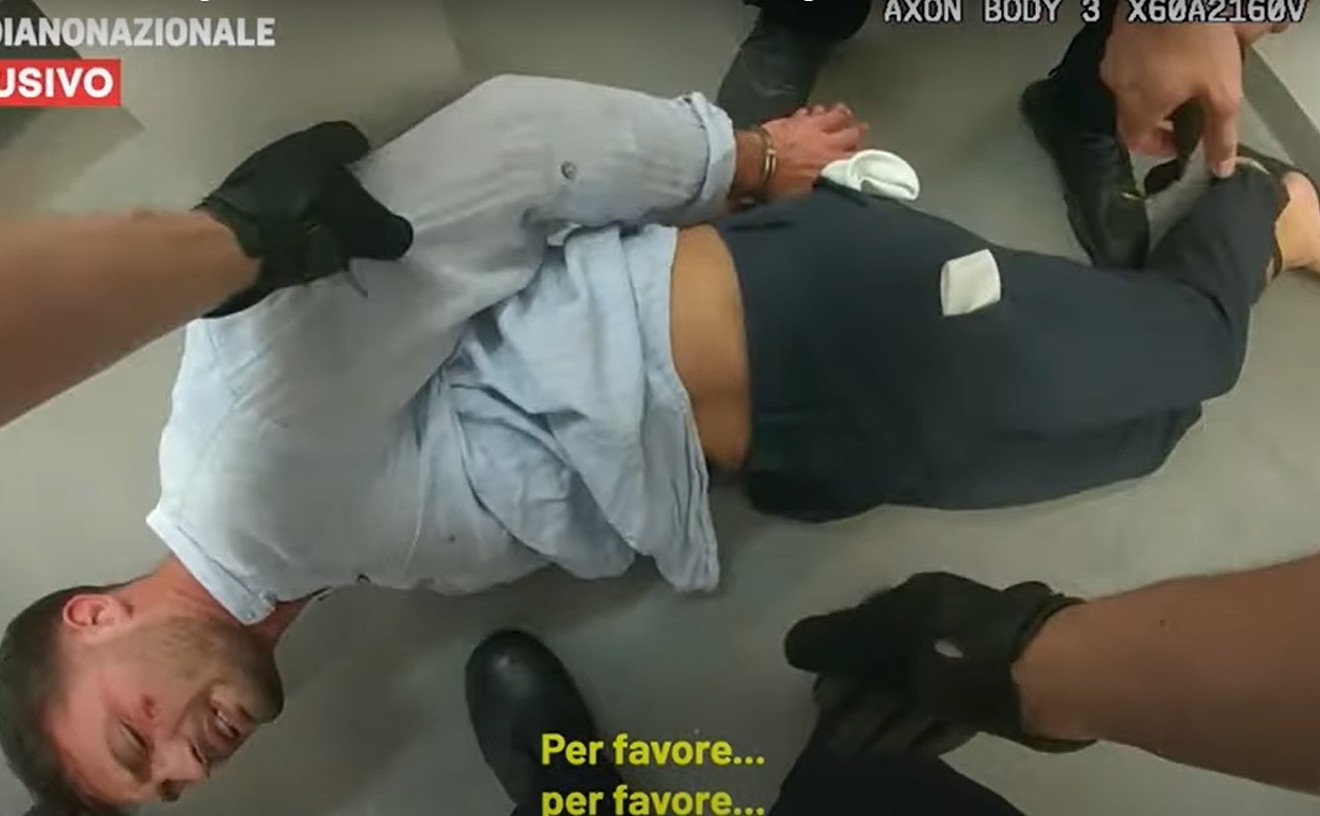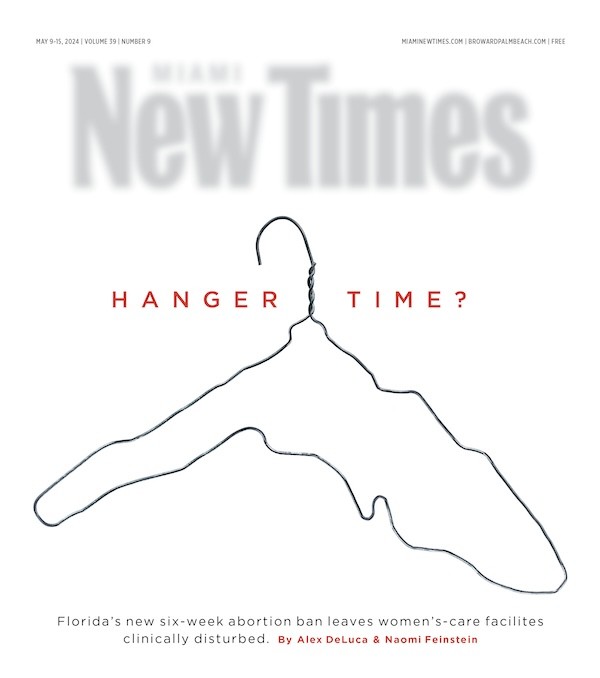If one decides to turn right at the sign, a little more than a half-mile past fences, concertina wire, and speed bumps is a guard post. It is just the first of several checkpoints on the way to the interior of a camp few outsiders know. This is the only part of America that some would-be immigrants will ever touch, except for the airport or beach where they come ashore.
That's not to say that Krome is completely unknown. During its eighteen-year history, the center has been forced into the public eye by a litany of scandal, usually brought to light by lawyers, journalists, and whistle blowers. Throughout the 1990s news accounts have detailed allegations of inmate neglect, sexual misconduct, beatings, and guards' use of stun guns. Detainees regularly staged hunger strikes. Advocates held demonstrations to protest the conditions and testified before innumerable boards to draw attention to abuses. In 1990 two teachers who worked at Krome were removed after complaining to the media about inmate treatment. In 1995 INS officials misled a seven-person congressional delegation about camp conditions. The incident blossomed into a scandal popularly known as "Kromegate," which resulted in the removal of the facility's Officer in Charge (OIC), Constance Weiss. (A civil service judge subsequently exonerated Weiss, concluding that she just followed orders.)
It wasn't until September 14, 1998, that Edward Stubbs, a Miami native who ran the U.S. Marshals Service's Palm Beach County office, was appointed as OIC. (Several others served on an interim basis.) Stubbs's daunting task involves nothing less than an overhaul of the wayward institution. Many believe he is off to a promising start. In his first three and a half months, he has won kudos from some community groups and the Miami Herald for his frank assessment of Krome's problems, as well as his responsiveness, ambitious capital improvement plan, and release programs. Skeptics caution that it's premature to declare victory. Many of Stubbs's most serious challenges stem from a changing U.S. immigration policy and a recalcitrant INS bureaucracy.
One factor in Stubbs's ultimate success might be a unique experiment that he inherited. A year before his arrival, two young public interest lawyers began working within the institution. Representing organizations that frequently criticize the INS and Krome, they could be the new OIC's most helpful allies or his harshest critics.
Fresh from law school, Tina Fassnacht and Stacy Taeuber began their professional careers in jobs that quickly became part of a crusade. Sponsored by the Florida Immigrant Advocacy Center (FIAC) and the Catholic Legal Immigration Network (CLINIC) respectively, the pair came to Krome to help detainees seeking asylum. In most cases the lawyers help clients to prove a "credible fear" of persecution in their native countries. The two also report on conditions and help noncitizens convicted of crimes fight deportation, among other things.
During their seventeen months at the camp, each has struggled to cope with a never-ending stream of human suffering. They are an unlikely pair, different in temperament and background. Taeuber, slender and usually soberly dressed, is a long-time activist whose car is covered with bumper stickers that embrace causes ranging from disarmament to ending U.S involvement in Central America. The daughter of academics at the University of Wisconsin, she is every bit the even-keeled midwesterner. Fassnacht, with a ready smile and curly hair, is a conservative from a small town in New York State. Effusive and warm, she is the type to argue with INS officials one day and then bring them home-baked cookies the next. Both Fassnacht and Taeuber aim to make Krome a more compassionate and logical place. Spending a few days with them gives one a sense of what it will take to change the camp.
For Tina Fassnacht a recent Thursday at Krome begins like most workdays: talking with Lulseged Dhine. The Ethiopian Jew has been held by the INS for nine years, longer than any other detainee presently in custody. He fled to the United States in 1978 after his parents and a brother were murdered. His three sisters have also disappeared into the turmoil of his native land. The INS gave Dhine conditional permission to enter the United States pending consideration of his residency application. But he started abusing drugs and by 1990 had accumulated seven misdemeanor convictions, more than half drug related. He attributes his actions to trauma from the loss of his family and lack of support in the United States, but insists he has mended his ways. "I made some small errors and I have paid a heavy price," he says. Because of the convictions the INS can deport him. But Dhine wants to stay because, he states, Ethiopians will persecute him for his Judaism. The INS has rejected the claim and his appeal. He is currently awaiting deportation.
Dhine is confined to a wheelchair because of a herniated disk, which is also the reason he is at Krome. On April 20, 1998, he was transferred from an Arizona detention center to the camp for back surgery. Eight months later he has yet to receive treatment. Wearing a yarmulke perched atop a cascade of dark curls, he wheels feverishly through the camp complaining, cajoling, and joking with guards and detainees alike.
Dhine, an articulate and intelligent 36-year-old who speaks nine languages, is a steady source of referrals for the two lawyers and a constant critic of camp conditions. (Stubbs has taken to holding weekly meetings with Dhine, which the OIC jokingly calls Dhine days.) "We have worked well together," the inmate says of Fassnacht and Taeuber. His activism has occasionally exasperated officials and angered some guards. "Everything has been confrontational with him because he stands up for other people," explains Fassnacht.
The focus of Dhine's outrage on this Thursday is Krome's infirmary. Until recently the camp had a reputation for providing excellent medical care both in its clinics and through a program that allows detainees treatment at area hospitals. Detention centers in more remote parts of the country send patients to Krome for treatment. (The INS operates nine centers like Krome and contracts out another seven.) Lately though, with the help of Dhine and the two lawyers, allegations of mistreatment and unhygienic conditions have been reported. Detainees have even criticized Larkin Community Hospital, where several patients have been sent.
On November 3 Dhine contends he was left in a storage closet for several hours while awaiting treatment at Larkin. Several other inmates have also complained about the hospital, alleging they were given only one meal per day, had to wait hours for attention, and were segregated from the general population. Hospital administrators deny the charges, saying that detainees receive much-coveted private rooms and the same high standard of care as all patients.
Today Dhine is scheduled to go to Larkin for surgery and he is in a panic. Early that morning a Jamaican detainee named Ashley Anderson, who suffered from a variety of infirmities including sarcoidosis -- a mysterious malady that inflames tissue in the lungs and other organs and is fatal in only five percent of cases -- died at Larkin from the disease. Anderson arrived at Krome in July 1998 with festering bedsores that worsened at the clinic. Krome staff injured Anderson, who was overweight, when they tried to move him from his wheelchair. In addition Dhine says the Jamaican went for long periods without being bathed. The INS refused Fassnacht's request to see Anderson at the clinic. His condition worsened until he was transferred to Larkin on October 7. On November 17 she asked to see him at Larkin. Two days later Anderson died. "He was a very ill man," explains Dr. Jack Michel, Larkin president and CEO. "This was not someone who was up and walking around and then just dropped dead."
Dhine insists he won't go to Larkin until he has more information about what the doctors' plans for him include. He and Anderson were close. "I had a good connection with him," he says. "I believe it was a wrongful death."
Fassnacht tries to persuade Dhine not to reject treatment. But she can do little beyond listen to his concerns. "I tried to calm him down," she says wearily after the interview.
After finishing with Dhine, Fassnacht returns to the small room she shares with Taeuber and FIAC paralegal Serge Fleurimond, a 46-year-old Haitian immigrant who came to the United States in 1984. Fleurimond is very protective of the two women. Fluent in Creole and Spanish, he works with many asylum applicants, allowing the lawyers to concentrate on other areas.
As Fassnacht enters the office, automatic-weapon fire from a nearby shooting range, the Muzak of Krome, crackles in the background. The 30-year-old Fassnacht had some idea of camp conditions when she joined the project. As a third-year student at St. Thomas Law School in North Miami in 1996, she worked in an immigration clinic and occasionally interviewed clients at Krome. She enjoyed the work, much to the chagrin of her parents. Fassnacht had originally planned a career in business, but abruptly decided to enroll in law school instead. Her upbringing in the small farming community of Montgomery, New York, where her parents run a catering concern, is far removed from the human suffering of detention centers and the maddening INS bureaucracy.
"In the beginning [FIAC Director Cheryl Little] said I was naive to expect that people would act in a decent way," she recalls.
The attorneys' workspace is not much of an office: about eight-feet wide by twenty-feet long. It is the largest of the four attorney visitation rooms located across the hall from Krome's lobby. The office is divided in half by a wooden table that separates the detainees from the lawyers. Each side has its own door. The walls are padded and the ceiling is foam. Occasionally when the immigrants' clamors for help has overwhelmed her, Fassnacht gently bangs her head against the wall. In a corner on the attorneys' side of the room is a black file cabinet with a printer and fax machine on top. Packets of Ibuprofen, mints, and antibacterial lotion litter the empty space between the devices. It's a small universe, but it didn't come without a fight.
It took Fassnacht and Taeuber almost six months to obtain the space. INS officials in Washington were willing to give them what they needed, but those in the district were slow to accept the women, the lawyers contend. INS spokesman Andrew Lluberes asserts the project was endorsed at every level. "It was start to finish a cooperative and coordinated effort that all three parties, if you will, the Office of International Affairs [in Washington, D.C.], the region [based in Vermont], and the district worked on to make happen," Lluberes says.
But in the beginning the two women carried their files, law books, and equipment in the trunks of their cars. They set up shop in the detention center's lobby and hoped like hell that the largest of four attorney visitation rooms would become available. Otherwise they would be crammed into a closetlike room even smaller than their current space. Sometimes, if a detainee did not speak English, the women brought in an interpreter and they would all pile into the tiny quarters.
According to the lawyers some Krome administrators showed their displeasure. The women's requests to plug in their computers and fax machines, as well as operate cell phones, were initially rejected as security risks. In the beginning the INS even sometimes restricted their access to clients, the lawyers remember. Officers would take up to eight hours to bring a client to the visitation room, or falsely declare the person was not at Krome, a practice that has since ended. Interpreters who charged between $50 and $100 per hour often waited during the delays, depleting scarce funds. (The Ford Foundation ponied up $75,000 in the project's first year and $50,000 in the second. A two-year grant of $100,000 from the Florida Bar Foundation pays for Fleurimond.)
To understand the INS one must think counterintuitively, the lawyers say. A perfect example is a Canadian client Fassnacht speaks to after she finishes with Dhine. Paul Miljour sits in an attorney visitation room at Krome, fidgeting in his orange uniform. The 37-year-old is clean-shaven with stringy blond hair that falls around his reddish face. His blue eyes dart about the attorney's room with the nervous energy of a caged animal.
This is not what Miljour expected. A couple of months ago his girlfriend Amy Fecteau bowled the best in her league back in Ottawa and won an all-expenses-paid vacation for two to Fort Lauderdale. "She's a super girl," he says proudly.
Miljour wasn't sure whether he was eligible to enter the United States. "I'm not a saint," he admits. Miljour was convicted in Canada of robbery, possession of stolen property, and other crimes. He was sentenced to one year, but served three months in a halfway house. Until he arrived at Krome on November 14, he drove a van for schoolchildren in the morning and made deliveries in the afternoon. When he boarded an airplane for South Florida, he had no idea of the consequences. "I got excited on flying for the first time. It felt good. Now I can't wait to get back on an airplane."
Indeed, Miljour's one-year sentence made him ineligible for admission to the United States. He also showed up on the Interpol system as wanted by the Canadian government, says INS spokesman Dan Kane. (Kane contends he was wanted for "document fraud." Miljour asserts that's false.) But instead of returning him immediately, the INS sent him to Krome. Miljour even signed a document accepting voluntary deportation. "I don't know why they kept me," he says. "I thought they would just put me on a plane."
Despite recent immigration legislation that allows for immediate deportation in some cases, Kane says such action is sometimes delayed. "Expedited removal does not mean we are going to put you on Air Canada two hours later," he says. Moreover, recent law changes have dramatically altered the legal landscape for immigrants and foreign visitors. The Illegal Immigration Reform and Immigrant Responsibility Act of 1996 gives wide discretion to the INS to reject visitors to the United States, even if they have valid visas. There is no appeal. Along with the Anti-Terrorism and Effective Death Penalty Act of the same year, this law defines a wide gamut of offenses, including past crimes, as grounds for deportation. The result has been a dramatic increase in detention rates. Between fiscal years 1995 and 1998, the average number of people held by the INS each day increased from 6600 to about 16,000. To deal with the influx the government now warehouses more than 50 percent of detainees in county jails.
It's day five of Miljour's detention at Krome. He fears a prolonged absence will cost him his job. To make matters worse, he has tried on three occasions to talk to his assigned deportation officer, but received no response. "I'll sign any forms," he pleads. "I give my right and left hand that I will never come back." (Kane says Miljour had probably been placed in line for a hearing with an immigration judge.)
Uncertainty about status disturbs many Krome detainees. A strategy used at an INS detention center in Florence, Arizona, seems to have successfully tackled the problem of educating inmates. There, pro bono attorneys and others work in cooperation with INS officials. The project is somewhat similar to Krome's, but the attorneys in Arizona give presentations about inmates' rights to all new arrivals.
"What bothers me the most is you are kept in the dark," Miljour says. "If somebody told me when I could leave, I would have something to look forward to. But everything stays in the dark. Stomach stays in the dark. Mind stays in the dark. Feelings stay in the dark. Thoughts stay in the dark."
Miljour is detained in Building Eight, which has space for several hundred people in six rooms called pods. The building was inaugurated in April 1998, five months before Stubbs arrived, as the first step to a better Krome. INS District Director Wallis called it "a place that is modern, clean, safe and, most importantly, humane," according to the Miami Herald.
But the building has become a focus of complaints. "There is no privacy," says Miljour. "It is just one big room." He frets that the air is stifling and unhealthy. While watching television, inmates can see whomever is in the shower or on the toilet, he says. "When someone goes to the bathroom, everyone in the dorm yells, 'Flush it! Flush it!'" says another prisoner.
Miljour says he learned about Fassnacht and Taeuber from a fellow inmate. After Fassnacht meets with Miljour, she contacts his deportation officer and obtains the correct forms. Eleven days after arriving in Florida, Miljour finally goes home. His girlfriend has already departed. "I can't wait," he says on the day before he is set to leave. "I want to put it behind me. I still can't figure out exactly why I am here. Back in Canada you would never see this happening."
Fassnacht's day is winding to a close. But before leaving she first must meet with five Guyanese youths who are requesting asylum. After about two weeks in Krome, one of them saw the lawyers' names on a social services list by the dorm phone and called. "[Fassnacht] told us she'd try her best to defend us. She helped find out about our situation and we put in for [asylum]," says one. A ringing telephone interrupts the conversation about every two minutes. Fassnacht is putting out fires. At one point she asks if anyone knows how to say "tomorrow" in Creole. She offers advice when she can and sets up appointments. At rushed times during the day she often talks on two phones at once. "Every time you turn around, somebody needs your help," she explains.
Dhine wheels into view in a nearby doorway. He is still furious about Anderson's death. "He was treated like a dog and he died like a dog," Dhine shouts. Fassnacht is not going to escape blame. "He was neglected legally also," Dhine continues. "This is my darkest day. How long have I been complaining about this? What happened is wrong," he says. Fassnacht puts her head in her hands.
She decides to talk with Dhine once more and a guard lets her into the camp's interior. Her office, like all the attorney visitation booths, is not wheelchair accessible. (Neither is Building Eight). Before Fassnacht can talk with Dhine privately, the 6:00 p.m. count begins. The Krome population isn't supposed to exceed 400, but it has numbered close to 500 in the past. Inmates are counted at least three times daily. Today, as is often the case, officials can't reach a number that corresponds to the recorded population. They repeat the census again and again.
Guards openly joke about the ridiculous nature of working at Krome. Employee discontent is high and morale low. The guards frequently work twelve-hour shifts with only two fifteen-minute breaks, forcing them sometimes to choose between going to the bathroom or eating lunch. At one point during the day, a guard bemoans the fact that Hurricane Andrew didn't destroy the facility. Stubbs's harshest critics may actually be the Krome guards. In recent years they have been burned by the uncomfortably quick succession of supervisors. Long hours, stressful work, disputes with management, and ever-changing policies have bred distrust. During the count Stubbs passes through the hallway. Asked how it's going, he jokes, "I was 33 when I took this job, I'm 46 now."
Dhine talks to Fassnacht in a voice that is loud enough for the OIC to overhear. "I bring everything into the open because I can't go to court to defend myself," he says. "I have a lot of respect for Mr. Stubbs, but he has to change [the clinic]."
"We are working on it," Stubbs replies, in what has become both a stock phrase and a mantra.
Fassnacht observes that Stubbs has a good sense of humor and that he will need it. He also seems to be that rare combination, she says: a tough administrator who is also compassionate. "Sometimes when you talk to [INS officials about inmate problems], you get a blank stare, like the detainees aren't human," she contends. "It seems like Stubbs understands they are human."
Even inmates note a change in the guards' demeanors. "A lot of these officers are trying to be nice since Mr. Stubbs comes," remarks one Jamaican awaiting deportation.
"What we have tried to do is have [staff] be more responsive," Stubbs says. "To raise the performance bar -- that will take time. This is virgin territory as far as implementing policy and procedures that make sense."
Stubbs insists he welcomes Fassnacht and Taeuber, but cautions they must have patience. "They are almost part of us by being in here," he remarks. "Nothing will get ignored, just give us fairness."
The count takes an hour and a half. Before it's finished, Fassnacht has given up and decided to drive home. She knows she will talk with Dhine again tomorrow.
Fassnacht's partner in the project, 32-year-old Stacy Taeuber, has been absent from Krome lately. Despite her Georgetown law degree, she has performed tasks better suited to a social worker while helping a Mexican immigrant fight deportation. Daniel Cardonia entered the United States illegally in 1979. The 36-year-old left a small village in the Mexican state of Guanajuato to work in the groves and vegetable fields of Florida. Like millions of other immigrants, he sent as much as half of his paycheck home each year.
In 1990 a police officer caught Cardonia and some other farm workers rolling a marijuana cigarette in Collier County. A judge convicted Cardonia of possessing under twenty grams of marijuana and released him on probation. After new legislation passed six years later, his drug conviction meant mandatory detention.
Then Daniel Cardonia contracted AIDS. In 1998 his kidneys failed. He sought treatment at the Florida Hospital Heartland Medical Center in Sebring. When he couldn't pay the $54,532.75 bill for his care, a hospital administrator called the INS and he was removed from his sick bed and sent to Krome. He is deportable on several grounds: He has a drug conviction, he entered the country illegally, he has a communicable disease, and he is a public charge. He will surely die much more quickly if he is returned to Mexico, Taeuber says.
It's Wednesday of the same week and Taeuber is at the office of the South Florida AIDS Network at Jackson Memorial Hospital. Though she knows Cardonia was transferred to a hospital the day before, she doesn't know which one.
Finally she tracks him down. He is in a room in Jackson's north wing with two armed INS guards posted outside. A sign on the door cautions visitors to wash their hands before they enter and leave. Inside lies a frail Cardonia, his arms covered in tattoos. A wispy beard hangs from his chin. His upper body is covered in hives that itch unbearably, he says. He lost his left pinkie after a wasp stung him a few years ago. His battered immune system was unable to stop an infection and gangrene set in. He complains of fevers and chills. "I've never seen anyone who is dying before," says Taeuber. "I still can't believe the hospital turned him in and that the INS is trying to deport him."
She recently won a humanitarian parole for Cardonia, which means he can live outside Krome while appealing his deportation order. She has no time to savor the victory. There are still many bureaucratic hurdles to clear while she looks for a program to take him.
Recently a group of Africans from Kenya, Togo, and South Africa visited the United States to gain insight on detention of immigrants and refugees. The INS provided a guided tour of Krome. The delegation didn't speak with inmates, but a guide called Krome a top-of-the-line facility renowned for its medical care and efficiency. The next day Fassnacht and other immigration lawyers told the group a different story. The attorneys described INS's arbitrary and nonsensical policies. They painted Krome as a place where investigations into abuse rarely lead to the truth and where there is no process for resolving grievances.
It is clear from listening to the Africans that Krome still compares favorably to immigrant detention facilities in their home countries. In some African nations refugee policy seems to consist of placing everyone in a camp run by the United Nations and leaving them there until conditions stabilize. Still, delegation members express uneasiness over the new trend in U.S. immigration policy. "What we are getting from you is that many of your laws are very punitive and it's scary," says David Nganga Kamau, a church official from Kenya.
Kamau also found similarities between U.N. and INS officials. "They have a great deal of power. They can do whatever they want." It is important to have outside observers, he concludes. "When it is just left to one institution, you can have all kinds of abuses."
During Thanksgiving week the INS allows Cardonia to leave the hospital for a Catholic AIDS hospice called Genesis. Taeuber bristles at the idea that the release is a victory: "This is not a success story. The INS still wants to deport him and he is going to die a gruesome death."
She also gives notice to CLINIC that she is leaving Krome to work at the immigration project in Arizona. CLINIC is advertising for a replacement.
Dhine continues to fight his deportation and has yet to undergo the back surgery that landed him in Krome. His latest campaign was to be allowed to light a candle for each day of Hanukkah.
FIAC has asked Physicians for Human Rights to launch an investigation into the death of Ashley Anderson and the conditions at the Krome clinics.
Krome OIC Stubbs recently announced an ambitious plan for capital improvements of the facility. He hopes to make Krome a fully equipped detention center. "As long as they keep on giving me money, I will keep on writing the checks," he says. Part of the modernization plan involves the health clinics. He also vows the new structures will not have the flaws of Building Eight. He compares fixing Krome to building a pyramid or a cathedral. The person who lays the first brick never gets to see its completion. "It takes time," Stubbs says.










